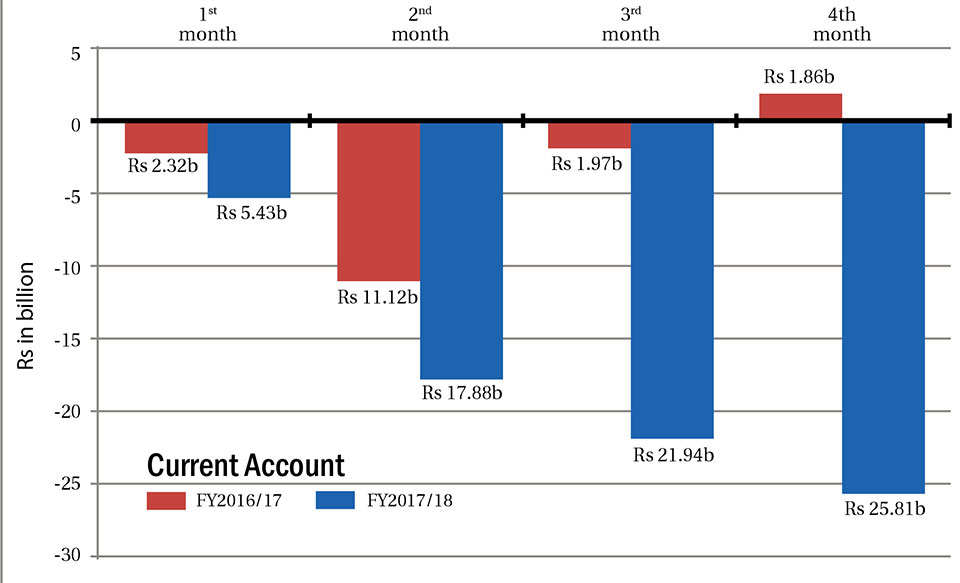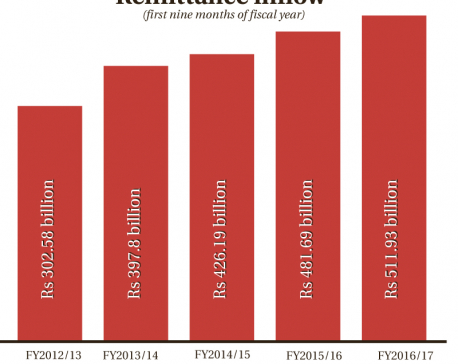
OR
Current account deficit at Rs 25.8 billion
Published On: December 25, 2017 02:15 AM NPT By: Republica | @RepublicaNepal

Officials say they will take needful measures to address the issue.
KATHMANDU, Dec 25: Negative growth in remittance coupled with continuous increment in import bills resulted in current account deficit of Rs 25.8 billion in the first four months of Fiscal Year 2017/18 ending mid-October, according to Nepal Rastra Bank.
Current account, which measures country's transactions with the rest of the world, saw a record deficit in the review period. Alarmed by the continuous rise in current account deficit, government officials say that they are mulling over taking steps to address the problem.
The current account was in surplus of Rs 1.86 billion in the first four months of FY 2016/17 that ended in mid-October.
“Decline in remittance inflow and import of goods like vehicle, motor parts and fuel are the major reasons behind rising current account deficit,” said finance secretary Shankar Adhikari. “It can be a short-term phenomenon due to election,” he added.
Remittance flow decreased by 1.4 percent to Rs 228.95 billion in the review period in contrast to a 7.8 percent growth in the same period of the previous year.
Merchandize imports, mainly petroleum products, MS billet, and vehicle and spare parts, have been rising continuously for the past many years. Import growth surprisingly moderated by 10.8 percent to Rs 334.31 billion in the review period compared to a whopping 87.4 percent growth in the same period of FY2016/17.
“Similarly, the overall Balance of Payment (BoP) situation remained at a surplus of Rs 2.40 billion in the review period compared to a surplus of Rs 21.98 billion in the same period of FY2016/17,” states the Current Microeconomic and Financial Situation of Nepal of first four months of 2017/18.
The BoP remained in surplus in the review period as there has been an improvement in the flow of foreign investment in the country. "Nepal received capital transfer amounting to Rs 6.42 billion and Foreign Direct Investment (FDI) inflows of Rs 10.17 billion in the period,” according to the central bank.
In the same period of FY 2016/17, capital transfer and FDI flows stood at Rs 3.38 billion and Rs 5.71 billion, respectively,” states the report.
Adhikari said that the ministry was closely studying the scenario and take prompt action for bringing more remittance via banking channel as well as to reduce import of vehicles which has also has prompted a rise in fossil fuel consumption,” he added.
Petroleum import saw a growth of 40 percent to Rs 40 billion, while import of vehicle saw a rise of 12 percent to Rs 34 billion in the first four months of Fiscal Year 2017/18.
NRB officials, however, say that there was nothing to worry as import of construction inputs like cement, rod, aluminum bars, cold-rolled sheet in coil, MS billet and MS rods is a reflection of growth in construction activities.
You May Like This

BOP, current account slip into deficit
KATHMANDU, April 13: The external sector of the country seems to be worsening as both current account and balance of payment... Read More...

Current account, BoP slip into deficit
KATHMANDU, Sept 23: Current account and balance of payment (BoP) of the country slipped into deficit in the first month... Read More...

Current account in deficit as remittances growth slows
KATHMANDU, May 17: Remittances growth slowed to 6.3 percent in the third quarter of the current fiscal year 2016/17, down from... Read More...




Just In
- Govt receives 1,658 proposals for startup loans; Minimum of 50 points required for eligibility
- Unified Socialist leader Sodari appointed Sudurpaschim CM
- One Nepali dies in UAE flood
- Madhesh Province CM Yadav expands cabinet
- 12-hour OPD service at Damauli Hospital from Thursday
- Lawmaker Dr Sharma provides Rs 2 million to children's hospital
- BFIs' lending to private sector increases by only 4.3 percent to Rs 5.087 trillion in first eight months of current FY
- NEPSE nosedives 19.56 points; daily turnover falls to Rs 2.09 billion















Leave A Comment